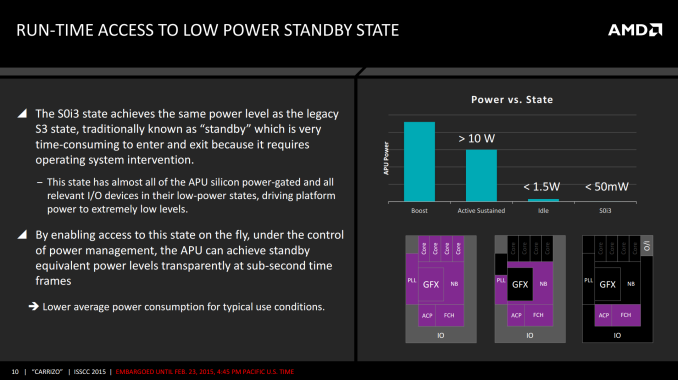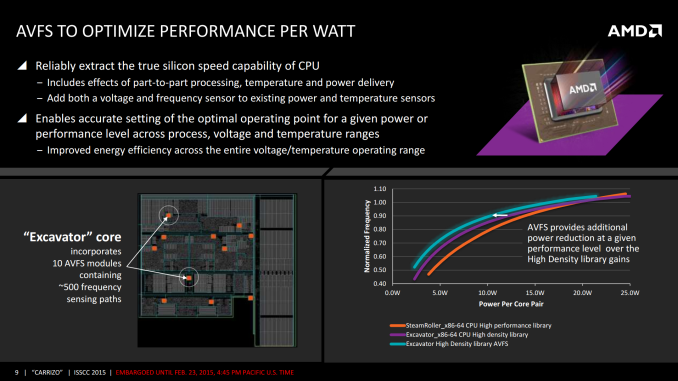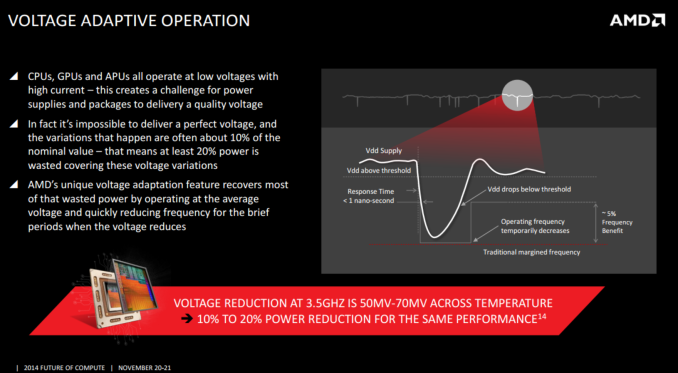AMD Launches Carrizo: The Laptop Leap of Efficiency and Architecture Updates
by Ian Cutress on June 2, 2015 9:00 PM ESTPower Saving and Power Consumption
When it comes to power, Carrizo features two/three technologies worth discussing. The first is the use of low power states, and the different frequency domains within the SoC. Previous designs had relatively few power planes, which left not as many chances for the SoC to power down areas not in use. Carrizo has ten power planes that can be controlled at run-time, allowing for what can be described as a dynamic race to sleep. This is bundled with access to the S0i3 power state, giving sub 50mW SoC power draw when in sleep and wake-up times under a second.
This is also combined with automated voltage/frequency sensors, of which an Excavator core has 10 each. These sensors take into consideration the instructions being processed, the temperature of the SoC, the quality of power delivery as well as the voltage and frequency at that point in order to relay information about how the system should adjust for the optimal power or performance point.
AMD states that this gives them the ability to adjust the frequency/power curve on a per-module basis further again to the right, providing another reduction in power or increase in frequency as required.
Next up for discussion is the voltage adaptive operation that was introduced back in Kaveri. I want to mention it here again because when it was first announced, I thought I understood it at a sufficient level in order to write about it. Well, having crossed another explanation of the feature by David Kanter, the reason for doing so clicked. I’m not going to steal his thunder, but I suggest you read his coverage to find out in more detail, but the concept is this:
When a processor does work, it draws power. The system has to be in a position to provide that power, and the system acts to restabilize the power while the processor is performing work. The work being done will cause the voltage across the processor to drop, to what we classically call Voltage Droop. As long as the droop does not cause the system to go below the minimum voltage required for operation, all is good. Voltage Droop works if the supply of power is consistent, although that cannot always be guaranteed – the CPU manufacturer does not have control over the quality of the motherboard, the power supply or the power conversion at hand. This causes a ripple in the quality of the power, and the CPU has to be able to cope with these ripples as these ripples, combined with a processor doing work, could cause the voltage to drop below the threshold.
The easiest way to cope is to put the voltage of the processor naturally higher, so it can withstand a bigger drop. This doesn’t work well in mobile, as more voltage results in a bigger power draw and a worse experience. There are other potential solutions which Kanter outlines in his piece.
AMD has tackled the problem is to get the processor to respond directly. When the voltage drops below a threshold value, the system will reduce the frequency and the voltage of the processor by around 5%, causing the work being done to slow down and not drain as much. At AMD’s Tech Day, they said this happens in as quickly as 3 cycles from detection, or in under a nanosecond. When the voltage drop is normalized (i.e. the power delivery is a more tolerable level), the frequency is cranked back up and work can continue at a normal rate.
Obviously the level of the threshold and the frequency drop will determine how much time is spent in this lower frequency state. We were told that with the settings used in Carrizo, the CPU hits this state less than 1% of the time, but it accounts for a sizeable chunk of overall average power reduction for a 3.5 GHz processor. This may sound odd, but it can make sense when you consider that the top 5% of the frequency is actually the most costly in terms of power than any other 5%. By removing that 5% extreme power draw, for a minimal performance loss (5% frequency loss for sub 1% of the time), it saves enough power to be worthwhile.













137 Comments
View All Comments
renegade800x - Thursday, June 4, 2015 - link
Although viewable it's far from being "perfectly" fine. 15.6 should be FHD.albert89 - Tuesday, June 23, 2015 - link
You don't need a strong CPU since win8 because most laptops use atom, Celeron or Pentium processors. AMD APU's are the natural choice !mabsark - Wednesday, June 3, 2015 - link
AMD should make Steam Box's. They already do APUs, chipsets (which are going on die) and memory. It would be pretty simple for AMD to partner with a motherboard maker. Imagine a Steam Box about the size of a router, with a nano-ITX motherboard, a 14 nm APU with HBM, wifi, a few USB ports and an HDMI port to connect to a TV.An AMD/Valve partnership could potentially revolutionise the console market, providing cheap yet powerful and efficient console-type PCs.
Refuge - Wednesday, June 3, 2015 - link
HBM isn't coming to APU's anytime soon.Cryio - Saturday, June 6, 2015 - link
Probably the first APU after Carrizocoder111 - Wednesday, June 3, 2015 - link
Aren't Steamboxes supposed to run Linux?AMD drivers for Linux are a bit weird. Catalyst is the official supported driver but it's buggy.
Open source drivers are quite good but they are slower than Catalyst and don't support latest OpenGL spec. There is no Mantle/Vulcan/HSA/Crossfire support with Open-Source drivers either. OpenCL is in alpha stage.
So AMD would need to man up and do the Linux drivers properly. They are working on it and making good progress but I doubt it is ready to be used at the moment as it is...
Besides, lots of games these days get developed with Nvidia's "help" to ensure they run well on Nvidia GPUs and run like crap on AMD GPUs. And if the games are built using Intel Compiler, they'll run like crap on AMD CPUs as well. All of these tactics are anticompetitive and should be illegal IMO but who said the world is fair...
And don't get me wrong, I love AMD, I use Linux + AMD dGPU + APU, but I don't think it's ready for the masses yet.
AS118 - Wednesday, June 3, 2015 - link
I agree. I'm a double AMD Linux gamer and I've run into the exact same problems as you have, and I wish they'd be more serious about Linux. Sure they have Microsoft's support, but I feel that they should take Linux more seriously outside of the enterprise (where they do take Linux more seriously).yankeeDDL - Wednesday, June 3, 2015 - link
I disagree.For casual gaming on laptops, 1366x768 is just fine. You'll need a lot more horsepower to drive a fullHD screen and battery life will suffer.
I won't say that there's no benefit gaming at fullHD vs 1366x768: obviously, the visuals are better, but if you want an "all rounder" laptop which does not weight one ton (like "real" gaming laptops) and that it is below $500, it's not bad at all.
BrokenCrayons - Wednesday, June 3, 2015 - link
I personally would rather have a cheap 1366x768 panel. I don't care about color accuracy much, light bleed, panel responsiveness or much of anything else and haven't since we transitioned from passive to active matrix screens in the 486 to original Pentium era of notebook computers. In fact, I see higher resolutions as an unnecessary (because I have to scale things anyway to easily read text and interact with UI elements and because native resolution gaming on higher res screens demands more otherwise unnecessary GPU power) drain on battery life that invariably drives up the cost of the system to get otherwise identical performance. The drive for progressively smaller, higher pixel density displays is a pointless struggle to fill in comparable checkboxes between competitors to appease a consumer audience that has been swept up in the artificially fabricated frenzy over an irrelevant device specification.yankeeDDL - Wednesday, June 3, 2015 - link
I think it depends on the use, ultimately.For office work (i.e.: much reading/writing emails), a reasonably high resolution helps making the text sharp and easier on the eyes.
For home use (web browsing, watching videos, casual gaming) though, I find it a lot less relevant.
Personally, at home, I rather have a <$400 laptop always ready to be used for anything, to be moved around, even in the kitchen, than a $1000 laptop which I would need to treat with gloves for fears of damaging. Since Kaveri I also started recommending AMD again to my friends and family: much cheaper than Intel and with a decent GPU makes them a lot more versatile. Again, my opinion, based on my use. As they say: to each his own...